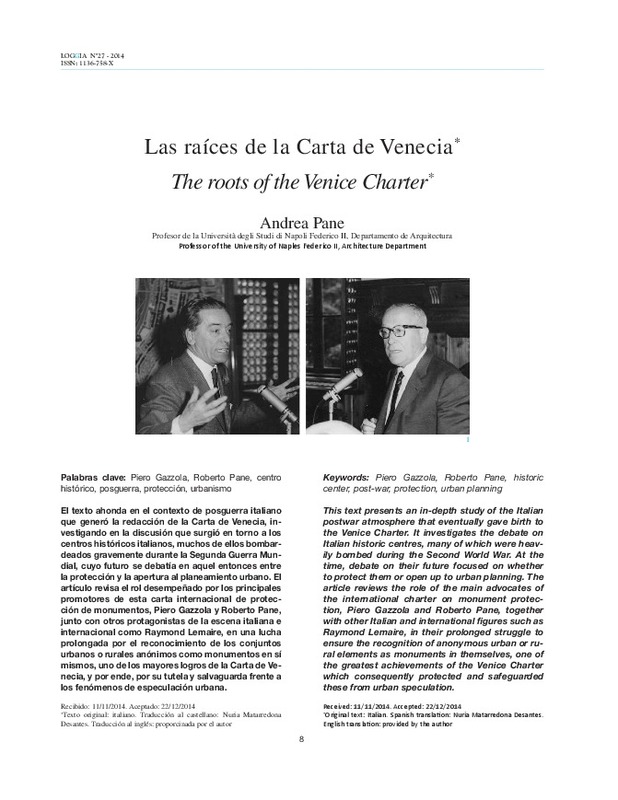JavaScript is disabled for your browser. Some features of this site may not work without it.
Buscar en RiuNet
Listar
Mi cuenta
Estadísticas
Ayuda RiuNet
Admin. UPV
Las raíces de la Carta de Venecia
Mostrar el registro sencillo del ítem
Ficheros en el ítem
| dc.contributor.author | Pane, Andrea
|
es_ES |
| dc.date.accessioned | 2016-09-28T09:48:08Z | |
| dc.date.available | 2016-09-28T09:48:08Z | |
| dc.date.issued | 2015-06-17 | |
| dc.identifier.issn | 1136-758X | |
| dc.identifier.uri | http://hdl.handle.net/10251/70561 | |
| dc.description.abstract | [EN] This text presents an in-depth study of the Italian postwar atmosphere that eventually gave birth to the Venice Charter. It investigates the debate on Italian historic centres, many of which were heav-ily bombed during the Second World War. At the time, debate on their future focused on whether to protect them or open up to urban planning. The article reviews the role of the main advocates of the international charter on monument protec-tion, Piero Gazzola and Roberto Pane, together with other Italian and international figures such as Raymond Lemaire, in their prolonged struggle to ensure the recognition of anonymous urban or ru-ral elements as monuments in themselves, one of the greatest achievements of the Venice Charter which consequently protected and safeguarded these from urban speculation | es_ES |
| dc.description.abstract | [ES] El texto ahonda en el contexto de posguerra italiano que generó la redacción de la Carta de Venecia, investigando en la discusión que surgió en torno a los centros históricos italianos, muchos de ellos bombardeados gravemente durante la Segunda Guerra Mundial, cuyo futuro se debatía en aquel entonces entre la protección y la apertura al planeamiento urbano. El artículo revisa el rol desempeñado por los principales promotores de esta carta internacional de protección de monumentos, Piero Gazzola y Roberto Pane, junto con otros protagonistas de la escena italiana e internacional como Raymond Lemaire, en una lucha prolongada por el reconocimiento de los conjuntos urbanos o rurales anónimos como monumentos en sí mismos, uno de los mayores logros de la Carta de Venecia, y por ende, por su tutela y salvaguarda frente a los fenómenos de especulación urbana. | es_ES |
| dc.language | Español | es_ES |
| dc.language | Inglés | es_ES |
| dc.publisher | Universitat Politècnica de València | |
| dc.relation.ispartof | Loggia, Arquitectura & Restauración | |
| dc.rights | Reconocimiento - No comercial - Sin obra derivada (by-nc-nd) | es_ES |
| dc.subject | Piero Gazzola | es_ES |
| dc.subject | Roberto Pane | es_ES |
| dc.subject | Historic center | es_ES |
| dc.subject | Post-war | es_ES |
| dc.subject | Protection | es_ES |
| dc.subject | Urban plannig | es_ES |
| dc.subject | Centro histórico | es_ES |
| dc.subject | Posguerra | es_ES |
| dc.subject | Protección | es_ES |
| dc.subject | Urbanismo | es_ES |
| dc.title | Las raíces de la Carta de Venecia | es_ES |
| dc.title.alternative | The roots of the Venice Charter | es_ES |
| dc.type | Artículo | es_ES |
| dc.date.updated | 2016-09-09T10:52:12Z | |
| dc.identifier.doi | 10.4995/loggia.2014.3946 | |
| dc.rights.accessRights | Abierto | es_ES |
| dc.description.bibliographicCitation | Pane, A. (2015). Las raíces de la Carta de Venecia. Loggia, Arquitectura & Restauración. (27):8-23. https://doi.org/10.4995/loggia.2014.3946 | es_ES |
| dc.description.accrualMethod | SWORD | es_ES |
| dc.relation.publisherversion | https://doi.org/10.4995/loggia.2014.3946 | es_ES |
| dc.description.upvformatpinicio | 8 | es_ES |
| dc.description.upvformatpfin | 23 | es_ES |
| dc.type.version | info:eu-repo/semantics/publishedVersion | es_ES |
| dc.description.issue | 27 | |
| dc.identifier.eissn | 2444-1619 | |
| dc.description.references | R. Pane, Passage de l'idée du monument historique isolé à l'idée d'ensemble historique ou artistique, en Conseil d'Europe, Principes et méthodes de la conservation et de la réanimation des sites et ensembles d'intérêt historique ou artistique. Défense et mise en valeur des sites et ensembles d'intérêt historique ou artistique, Rapport (Bath 3-7 oct. 1966), Strasbourg 1967, pp. 35-40. | es_ES |
| dc.description.references | M. Tafuri, Storia dell'architettura italiana, 1944-1985, Einaudi, Torino 1982, p. 5. | es_ES |
| dc.description.references | C. Olmo, Urbanistica e società civile. Esperienza e conoscenza. 1945-1960, Bollati Borighieri, Torino 1992. | es_ES |
| dc.description.references | L. Falco, La rivista «Urbanistica» dalla fondazione al 1949, «Urbanistica», n. 76-77, diciembre / december 1984, pp. 20-21. | es_ES |
| dc.description.references | A. Bellini, Il restauro architettonico, AA.VV., La difesa del patrimonio artistico, Mondadori, Milano 1978, pp.153-155. | es_ES |
| dc.description.references | A. G. Ricci, Aspettando la Repubblica. I governi della transizione 1943-1946, Donzelli, Roma 1996, pp. 142-150. | es_ES |
| dc.description.references | M. Tafuri, Storia dell'architettura italiana, 1944-1985, cit., p. 32; C. Olmo, Urbanistica e società civile, cit. | es_ES |
| dc.description.references | B. Croce, La «terza via», Id., Per la storia del comunismo in quanto realtà politica, Laterza, Bari 1944, pp. 27-36. | es_ES |
| dc.description.references | G. Rosi, Intorno all'ambiente dei monumenti e ai monumenti d'ambiente, Istituto Nazionale di Urbanistica, Convegno Nazionale di Urbanistica, cit., pp. 79-86. | es_ES |
| dc.description.references | C. Di Biase, Roberto Pane ed Ernesto Nathan Rogers: dibattito sugli inserimenti nelle preesistenze ambientali, in Roberto Pane tra storia e restauro, cit., pp. 364-369. | es_ES |
| dc.description.references | C. Olmo, Urbanistica e società civile, cit., pp. 66-69. | es_ES |
| dc.description.references | A. Cederna, M. Manieri Elia, Orientamenti critici sulla salvaguardia dei centri storici, in «Urbanistica», n. 32, diciembre 1960, p. 69. | es_ES |
| dc.description.references | M. Giambruno, Verso la dimensione urbana della conservazione, Alinea, Firenze 2002, pp. 108-113. | es_ES |
| dc.description.references | E. Salzano, Leggi e istituzioni, cit., pp. 352-353. | es_ES |








